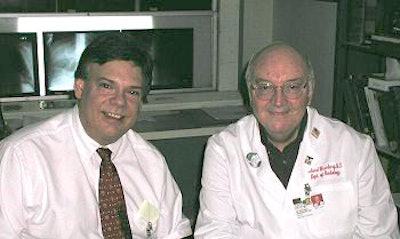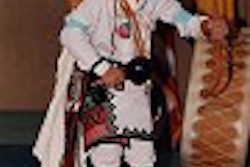
This month has been a little stressful for radiology resident Dr. Dennis Bielecki. Right after he finished taking the written board exam in diagnostic radiology, he had to evacuate his home in Mobile, AL, for Hurricane Ivan.
But persevering in the face of challenges is undoubtedly part of Bielecki's character. Why else would he be studying for the boards at an age when other radiologists are contemplating retirement?
Bielecki, 54, is now a fifth-year postgraduate (PGY5) resident in diagnostic radiology at the University of South Alabama Medical Center in Mobile -- a position he landed after a posting in the AuntMinnie.com Residents Discussion Group alerted him to a PGY4 opening.
Completing his residency despite a 15-year gap between PGY3 and PGY4 is just one of the challenges Bielecki has overcome on his way to achieving some long-held goals.
"I had even considered starting radiology over again, going through the Match and doing all of that, because even though I'm 54, I don't feel 54," Bielecki said.
"And I think anybody can achieve anything they want," added Bielecki, undoubtedly revealing the secret to his success. "You just have to want to do it, and then do it."
 |
| "I don't think the age thing is particularly a disadvantage to Dennis; he overcomes that with enthusiasm to learn the latest techniques and modalities," said Dr. Richard Wesenberg, professor of radiology and pediatric radiology at the University of South Alabama, pictured here (right) with Dr. Bielecki (left). |
Like many physicians, Bielecki developed his interest in medicine at a young age. But his very traditional Polish-American parents didn't support the notion of higher education, expecting that he would instead go to work as soon as possible, and support them financially as they aged.
Bielecki knocked about in various undergraduate courses for nearly 10 years after leaving high school in San Diego. When he finally entered a chiropractic college, he did very well, which provided him with the confidence to begin his circuitous journey.
Bielecki started working with Dr. Joseph Howe, one of his teachers from the Los Angeles College of Chiropractic, and a founding member of the American Chiropractic Board of Radiology. But Bielecki's experience with radiology mainly served to whet his interest in getting a medical degree.
So he decided to attend medical school in Poland. It seemed logical for someone who had grown up speaking Polish, but it was a choice that would complicate his later efforts.
Bielecki now advises other Americans to avoid the stigma of a foreign medical degree, even if their efforts to gain admission to a U.S. medical school have been frustrated. Instead, he says, would-be physicians should pursue a master's degree in a scientific field while continuing to apply to medical schools.
"If you're not admitted by the time you get your masters, get a Ph.D. because the person that tries the hardest will get in," he advised.
The traditional European medical education doesn't include as much practical clinical experience for students. So after graduating summa cum laude from the Nicholas Copernicus Medical Academy in Krakow (now the Jagiellonian University Medical College), Bielecki did a family practice internship at the University of Minnesota in Minneapolis.
"It's extremely difficult to leave this (U.S.) system and come back," Bielecki said. "In my situation I took the hardest road, and it took the longest time."
He later juggled jobs as a high school substitute teacher and a research assistant on the osteoradiology service at the VA Medical Center in La Jolla, CA.
Bielecki finally started a radiology residency in the Midwest three years after graduating from medical school. But after his program merged with another program, Bielecki found himself being treated differently to the point of being unbearable.
So in 1987 he left the residency after his third year, and returned to the VA in La Jolla as a musculoskeletal imaging research fellow. He spent another eight years heading his own medical transcription consulting firm, then returned to Poland in 1996.
He planned to finish his radiology training in Poland, but changes in that country meant that program directors no longer had the latitude to include someone who wasn't following the traditional educational sequence at an early age. But he stayed there for seven years nonetheless, working as a medical school instructor and consultant.
With encouragement and recommendations from several radiologists he'd gotten to know over the years, he returned to the U.S. again in 2002 for a job managing the radiology teaching files for a high-volume practice and, with his Ohio medical license in place, covering MR contrast injections as well.
Networking and good fortune also played a role when he saw the AuntMinnie.com discussion group posting on the PGY4 position at the University of South Alabama: One of his Ohio colleagues had just finished the same program and was happy to put in a good word for him.
So how is he faring now alongside the other residents, most of whom are decades younger?
"We seem to all get tired about the same amount," Bielecki said. But he makes at least one concession to age -- he doesn't moonlight like some of his younger colleagues.
"I would rather just study and get prepared for the boards and get finished," he said. "I've made some money in my life, and I know that once I finish the program I'll do well, so being patient for a year or two years is not a problem."
By Tracie L. Thompson
AuntMinnie.com staff writer
September 23, 2004
Related Reading
Preparing for the ABR oral exam: a resident's guide, February 19, 2004
Residents score their proverbial 15 minutes of fame, September 8, 2003
Online CME helps residents prove their mettle, January 15, 2003
Life after residency: Making the transition to practice, June 14, 2001
Radiology residents struggle to balance career and family, April 11, 2001
Copyright © 2004 AuntMinnie.com


















